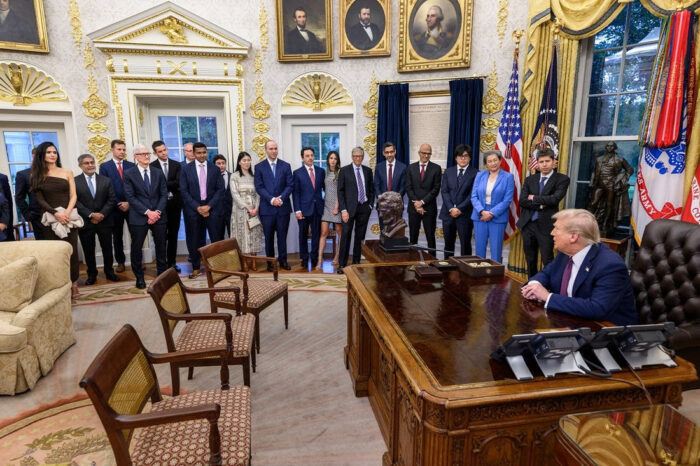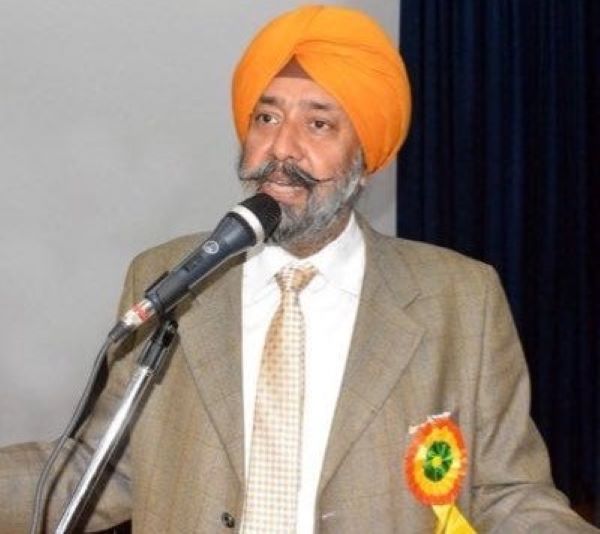 Picture two set-pieces within a matter of days this week: in New Delhi, Prime Minister Narendra Modi—just back from the Shanghai Cooperation Organisation Summit in Tianjin, China—inaugurates India’s semiconductor showcase, pitching “designed and made in India, trusted by the world.” In Washington, President Trump hosts a glittering White House dinner where Big Tech’s chiefs pledge colossal AI investments as the administration signals faster permitting, easier energy access—and sharper industrial policy. Each tableau telegraphs a doctrine: India’s state-backed bid to onshore the world’s most strategic manufacturing; America’s effort to fuse AI primacy with re-shored chip supply. The optics matter because capital, fabs and talent follow conviction.
Picture two set-pieces within a matter of days this week: in New Delhi, Prime Minister Narendra Modi—just back from the Shanghai Cooperation Organisation Summit in Tianjin, China—inaugurates India’s semiconductor showcase, pitching “designed and made in India, trusted by the world.” In Washington, President Trump hosts a glittering White House dinner where Big Tech’s chiefs pledge colossal AI investments as the administration signals faster permitting, easier energy access—and sharper industrial policy. Each tableau telegraphs a doctrine: India’s state-backed bid to onshore the world’s most strategic manufacturing; America’s effort to fuse AI primacy with re-shored chip supply. The optics matter because capital, fabs and talent follow conviction.
India’s policy spine is clear: a 50% capital subsidy, on a pari-passu, open-ended basis for fabs, display, compound semiconductors and ATMP/OSAT. That single line—backed by a ₹76,000-crore programme—turns “capital-intensive” from deal-breaker into deal-doable. And the world is taking notice: Semicon India 2025 drew roughly 2,500 delegates from 48 countries, alongside 350+ exhibitors and 150+ speakers—over 20,000 attendees in all—a vote of confidence that the pipeline is real, not rhetorical.
America, for its part, has matched subsidies to scale: Intel (up to $8.5bn), TSMC Arizona (up to $6.6bn plus loans, with a third fab now in scope), Samsung Texas (up to $6.4bn). CHIPS is not abstract policy; it is purchase orders for cleanrooms, tools and people. For India, the comparison is salutary: the direction is right; the question is speed and depth.
New Delhi has moved from talk to trench. Three units were approved in early 2024—including a Tata-PSMC logic fab at Dholera, a Tata OSAT in Assam, and a CG Power-Renesas OSAT in Sanand—with an explicit 100-day construction clock. Meanwhile, Micron’s ATMP at Sanand, Gujarat, began its phased build with first operations slated from late-2024 into 2025. These are not end-state victories, but they are the scaffolding of an ecosystem.
Trump’s AI dinner, tariff sabre—and what it signals for chips
The White House dinner did more than flatter egos. It knitted a political-industrial coalition around AI infrastructure—compute, energy, data centres—and hinted at levers to force localisation of supply chains. President Trump has now talked up “substantial” tariffs on semiconductor imports that do not shift production into the U.S., a threat that—real or rhetorical—rearranges boardroom calculus in Hsinchu, Austin and Bengaluru alike. Even if details evolve, the vector is unmistakable: higher U.S. barriers, bigger domestic carrots, and speed.
Trade and tech controls: the rules tightening around China
Overlaying tariffs is a hardening export-control regime on advanced computing chips and semiconductor equipment. The 2023–24 updates widened scope across AI accelerators and SME tools, added entities, and tightened licensing. Pair that with the Section 301 tariff path—semiconductor rates doubling to 50% by 2025 in the Biden-era package that the new administration is building on—and the policy perimeter around China-linked supply is visibly thickening. For India, that is a strategic opening to be the “friend-shored” node—if execution keeps pace.

Taiwan’s concentration risk—and the slow geographic spread
The geopolitical centre of gravity remains Taiwan, where TSMC still anchors the world’s leading-edge foundry capacity. Chinese drills encircling the island since Lai Ching-te’s inauguration underscored why Washington, Tokyo and Brussels want more redundancy. TSMC’s incremental spread—to Arizona and Kumamoto—helps, but does not erase concentration risk. For India, this is the moment to be part of the diversification map, not a spectator to it.
The data-centre dimension: energy, sovereignty and AI compute
AI’s gravity drags in data centres, where “compute” meets “kilowatts.” India’s operational DC capacity is on track to ~2.0–2.1 GW by FY27 (from ~1.15 GW in Dec-2024), and could consume ~3% of national electricity by 2030 as hyperscalers and cloud providers scale. The next wave is already queued up: the IndiaAI Mission funds a public compute backbone (10,000+ GPUs) and procurement; private capex is surging, with projects like a 1-GW campus reportedly planned in Andhra Pradesh. Rein in power intermittency, and this DC build becomes the demand anchor for indigenous chips.
Sovereignty is not just steel and silicon; it is also lawful control over data flows. India’s DPDP Act adopts a “blacklist” model for cross-border transfers—permitting flows except to countries notified as restricted—alongside sectoral localisation (notably, RBI’s payments-data rule). That framework gives policymakers the levers to insist that the crown-jewel datasets—defence, identity, payments—reside on Indian soil while still enabling cross-border AI collaboration.
Where India is advantaged—and where it must sprint
Scale and demand. India brings a vast electronics market, fast-growing DC demand, and an AI stack that will quickly soak up accelerators. Domestic offtake reduces the “empty fab” risk that has haunted greenfield attempts elsewhere.
Policy clarity. The 50%-capex architecture, combined with quick approvals for ATMP/OSAT and one leading-edge fab, is the right sequencing: start with assembly and advanced packaging; climb the process-node ladder with a partner; use public demand (IndiaAI, public clouds, defence) as anchor customers.
Geopolitical timing. With U.S. export controls tightening and tariff walls rising, global primes need diversified, trusted capacity. India’s democratic credibility and growing U.S.–India tech alignment amplify its attractiveness—as long as India can prove “time to tool” is competitive.
The path ahead: from conference to capacity
(The numbered list is crisp; only minor spacing and punctuation fixes made here for consistency)
Make ATMP + advanced packaging a national champion vertical. The AI bottleneck is not just wafers; it is CoWoS-class advanced packaging and HBM memory integration. India should designate two packaging “super-sites” with fast-track land, on-tap utilities, and a tooling queue guaranteed via vendor MOUs. Offer incremental subsidies tied to complexity (e.g., 2.5D/3D stacking, HBM interposers), with a five-year glide-path to localise substrates and specialty chemicals.
Close the talent and tape-out gap. Create a national multi-foundry tape-out programme—fund PDK access and shuttle runs across mature, specialty and one leading-edge node for universities and startups. Tie DLI-style grants to taped-out silicon, not just design files, and build a sovereign IP repository (open and licensed) around RISC-V, imaging, RF, and HPC primitives relevant to India’s priorities (defence avionics, telecom, power electronics).
Lock in one leading-edge logic path with a global partner. The Tata-PSMC plan is a start; India should parallel-process a second anchor—whether in logic, power, or specialty—so the ecosystem isn’t single-threaded. Structure government purchase commitments (for defence/space/identity) to de-risk initial volumes, and negotiate access-to-upgrade clauses so node shrinks can be staged without renegotiating the industrial policy every two years.
Treat data centres as a strategic off-take—and wire them with firm green power. Mandate 24×7 “green open access” for DCs with a firming obligation (pumped hydro, gas peakers, BESS) so AI farms are reliably powered without destabilising grids. Use pooled procurement (state discoms + hyperscalers) to sign 15–20-year contracts that underwrite new renewable capacity, transmission and storage.
Calibrate tariffs and standards to build—rather than balkanise—supply. Washington’s trajectory—export controls + tariff escalators—will keep rippling through global bill-of-materials. India should resist blunt autarky. Instead: remove inverted duties on upstream inputs (wafers, gases, tools), set performance-based customs relief for projects with defined localisation milestones, and align technical standards to assure plug-and-play with U.S./EU toolchains.
De-risk compliance on export controls. If India wants best-in-class EDA, tools and specialty materials, it must give suppliers confidence on end-use and re-export compliance. A single-window “trusted fab” certification mapped to BIS categories—plus penalties for diversion—will avoid ad-hoc licensing surprises that slow ramp-ups.
Put patient capital behind the middle of the stack. Create an anchor “Sovereign Silicon Fund” that takes minority, time-limited stakes in substrates, gases, specialty chemicals, and tool-service companies. The aim is to crowd-in private LPs and push mezzanine finance into the unglamorous but essential parts of the chain where bank debt is scarce and equity is wary.
Tie IndiaAI to “chips-in-India” procurement. As the public compute backbone scales past the first 10,000 GPUs, earmark a rising share of accelerator demand for systems assembled, packaged (and eventually fabbed) in India—while keeping platforms open so researchers aren’t trapped in a narrow hardware stack.
Make sovereignty operational in data. Use DPDP’s blacklist approach judiciously—protect the crown-jewel datasets (defence, payments, critical infrastructure) while enabling cross-border AI collaboration for benign workloads via standard contractual clauses and audits. RBI-style localisation for payments should be the template for a small set of “strategic verticals,” not a blanket.
Sovereignty in Silicon
Under Prime Minister Narendra Modi’s decisive political leadership, semiconductors are no longer treated as a narrow electronics or AI initiative but as an essential pillar of national security and sovereignty. That clarity of purpose has pushed the system into “mission mode.” The Ministry of Electronics and IT—under Ashwini Vaishnaw, a former IAS officer, and his dedicated cross-functional team—is moving projects from file to field with a no-longer-business-as-usual approach: underwriting half the capex for fabs and advanced packaging, fast-tracking clearances, and leveraging public demand from IndiaAI, defence, identity and payments to anchor offtake. If India executes with discipline—prioritising advanced packaging and HBM integration, securing at least one credible leading-edge logic path with global partners, wiring hyperscale data centres to firm, green power, and aligning trade and compliance regimes—SemiconIndia will evolve from a showpiece to a flywheel, with domestic demand underwriting supply and sovereignty expressed not as slogans but as silicon.
From MoUs to Megawatts
Even as New Delhi seeks to stabilise its uneasy ties with Beijing—while navigating Washington’s tariffs and shifting trade winds—it is no longer naive enough to depend on its northern neighbour for the most sensitive inputs of the digital age: GPUs, logic chips and heavy-duty semiconductors. The lesson is clear: supply chains built on adversarial dependencies are vulnerabilities, not assets.
The window of opportunity is open, but in geopolitics such windows close quickly. India must now move beyond milestone-laden MoUs and ceremonial ribbon-cuttings, and into the discipline of execution: tool-ready cleanrooms, qualified yields, trained shifts, and purchase orders that translate into wafers shipped and megawatts reliably delivered to hyperscale data centres. In semiconductors, as in statecraft, the only metric that ultimately counts is capacity on the ground—and India has chosen to build it.